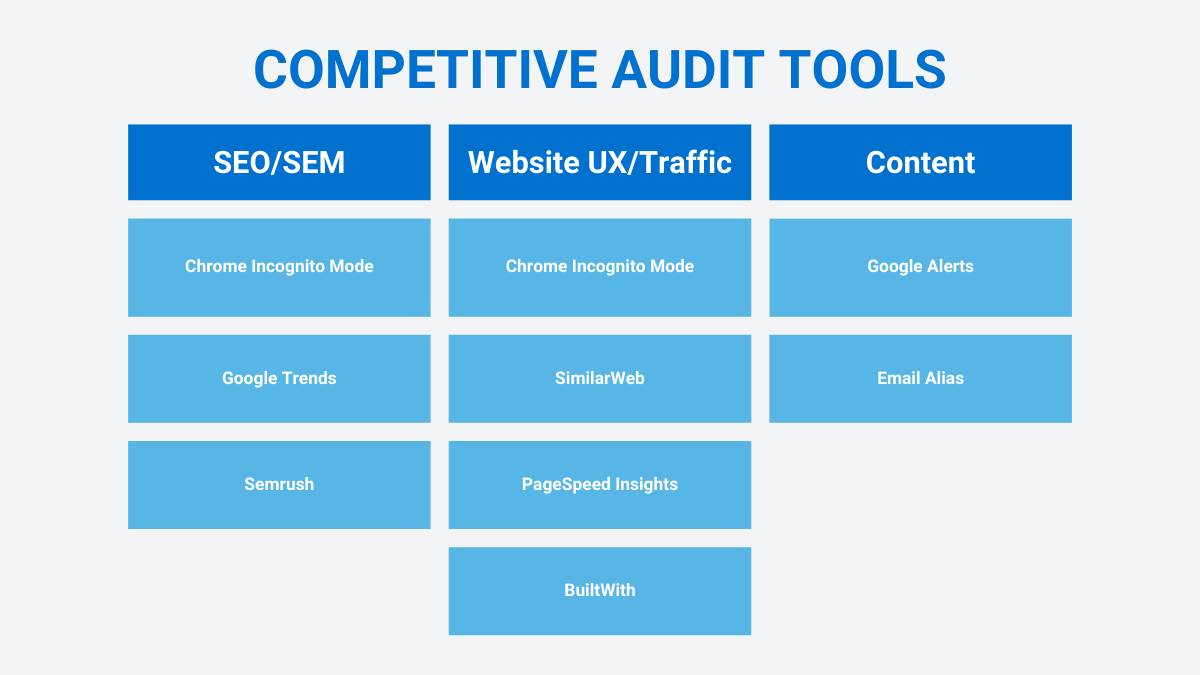We’ve all peeked over the fence to snoop on the neighbor’s new grill or their freshly painted trim. Call it curiosity or inherent competitiveness–we’re a species driven to be one step ahead.
But in business, the metaphorical fence-peeping isn’t just a hobby. It’s a necessity. Right now, your competitors are plotting ways to dip into your market share, beat you to a new lead, or peel away one of your loyal customers. Of course, to protect existing accounts and grow new business, you need to provide exceptional products and services–that’s table-stakes.
But you also need to craft a marketing and messaging strategy that outsmarts your peers. In order to execute your own tactics, you need to know what they’re doing, and then do it better.
You need to peek over the fence. Here’s how.

8 Essential Research Tools
What Information Can You Gather?
A surprising amount, actually. Having an internet presence requires organizations to leave digital breadcrumbs. Those include little bits of code that reveal a marketing automation tech stack and search keywords a company is targeting in both organic and paid campaigns. You don’t have to be an expert in digital forensics to reveal a decent sketch of your competitor’s overall marketing strategy. Even better? You don’t have to invest a significant amount of money to get started.
With a bit of time and for (almost) no money, you can find:
- SEO and SEM Tactics: Where do organizations organically rank better than you? Which keywords are they targeting in paid campaigns? There are many services that tell you both.
- Website Performance, UX, and Traffic: From page speed load time to a snappy new lead-capture software to an estimate of monthly site visitors–you can learn how sophisticated (and successful) a company’s website really is.
- Content and Industry Updates: Proactively set up alerts to learn about new product launches, conference attendance, or anything your competition chooses to share publicly with their digital audience.
8 Tools to Help You Complete a Free(ish) Competitive Audit
Most marketing agencies (including ours) begin every client relationship with a competitive audit. We use some sophisticated (and expensive) tools to provide precise and actionable information that guides an integrated marketing plan focused on driving results.
If you’re not quite ready for an agency partner, or you want to conduct your own initial research, these tools provide a solid foundation. For (almost) no money.

The vast majority of websites you visit drop a tiny digital breadcrumb, called a cookie, into your browser. In general, these cookies are incredibly useful for marketers–they allow us to precisely target messaging to a promising lead. When not used maliciously, they are also essential for end users. Cookies allow Google to recommend restaurants in your town when you search “Thai food.” They’re also the reason you don’t have to log in every single time you open a social media account in a browser.
During a competitive audit, though, cookies cause problems. If you Google a keyword relevant to your business’ industry, for example, you are likely to see your own company appear far higher than a different user. That’s because you’ve almost certainly visited your company’s site within the past month. Google knows this, so it’s algorithm believes your site is the most relevant content for you.
Enter, Google Chrome’s Incognito Mode. With a click of a button, you can strip all cookie and browser history information to mimic the experience of a first-time user. You’ll get an accurate picture of clean search results, stripped of your recent browsing habits.
Incognito mode is also useful when visiting a competitor’s site. They might be implementing a strategic messaging journey based on the number of a user’s pageviews (i.e., a small banner on the bottom of the screen for the first visit, and a large pop-up on the fourth). Incognito mode gives you the clearest picture of a site’s UX, especially as presented for first-time visitors.
Google Alerts: To Monitor Content
There are a few powerful (and expensive) tools that allow you to conduct deep research on your competitor’s content strategy. Sites like MuckRack and BuzzSumo analyze your rivals’ social performance, keyword targets, and even media mentions.
While those services provide incredible value (not just for a competitive audit, but also for your own content marketing tactics), you don’t need to spend any money if you just need to monitor content. Creating a tailored Google Alerts report targeting company names and key industry phrases gives an excellent (and free) synthesis. You’ll be able to see when new blogs appear and know immediately when a target company appears in earned media.
Google Trends: For Keyword Volume and Growth
Just like content, SEO monitoring and strategy has morphed into a lucrative industry. Those tools are worth it when you need an accurate picture of keyword rankings and SEM tactics. But to get started, we recommend going straight to the source–Google itself provides a ton of useful out-of-the-box tools. Trends being one of our favorites.
Use Trends to look at search volume over time. You can track the growth, or decline, of brand recognition by searching a company’s name. You can also see which industry keywords are gaining or losing momentum.
One word of caution: B2B marketing is incredibly niche, meaning search volumes for phrases you want to monitor are likely low. The higher the volume, the more insight you can gain on the movement of a keyword.
Semrush: For SEO and Keyword Research
Our favorite tool for organic and paid search research. While the basic plan costs $129 per month, it provides invaluable info on how you and your competitor’s sites rank within your industry’s most desirable keywords. It also provides SEM reports, showing which phrases your peers are targeting in their paid strategy and the search ads they’re running.
SimilarWeb: For Website Traffic Analysis
Another paid tool that, for a deep competitor audit, is worth the price. SimilarWeb uses a proprietary algorithm to synthesize public browsing data. It gives you a rough estimate on website traffic, showing how sites compare to yours and growth over time. While the numbers are not 100% accurate, the tool is the next best thing to getting a peek at your competition’s Google Analytics dashboard.
PageSpeed Insights: For Website Performance
This free tool (from Google, of course) lets you take a peek under the hood of any website. Simply paste a URL into its engine, and you’ll get a fairly comprehensive report on things like page load time, code integration errors, and mobile performance.
The latter is especially relevant because Google only indexes sites based on their mobile experience. Is a competitor crushing you in organic rankings? One reason might be their technical engine. You’ll know in seconds whether or not yours needs a tuneup in order to compete.
BuiltWith: For a Website’s Tech Stack
Are your competitors using any marketing automation? What API integrations do they use? This free tool digs into any site’s technical guts and spits out a list of the third-party vendors that keep their lead generation and performance humming.
While we prefer Wappalyzer (a paid service that provides more detailed reports), BuiltWith is an excellent free tool to get you started. That’s because you might learn about best-in-industry marketing services that you aren’t taking advantage of.
Bonus! A Nifty Trick to Create an Email Alias
To monitor your peers’ email nurture and automation content, you’ll need to sign up for their newsletter lists. Do this for a dozen companies and your inbox might devolve into chaos.
Apple, Gmail, and Outlook all allow you to easily create email aliases that can help you quickly identify the source of (and then filter) messages. All you need to do is add a plus sign after the non-domain part of your email with a custom word or phrase. As in:
youremail+customphrase@yourdomain.com
Your email provider ignores everything after the plus sign. But services and newsletter lists treat it as a brand new address. This means you can “label” your email every time you sign up for a list. Once you do this, you can, with a quick scan, know why you are receiving an email. You can also create rules and filters that will keep your inbox more organized based on those labels.
(This strategy also allows you to sign up for free trials more than once, but you didn’t hear that from us).
Conclusion: The Research is Done. Now Comes the Hard Part
A competitive audit isn’t easy (or quick). But done right, you’ll have a pile of actionable information. The most detailed (and useful) audits require paid services–or an expert to do it for you. But you can still gather a significant chunk of information without spending a ton of money.
The hard part? Know what to do next. You’ll need to parse the data to create a marketing strategy built to outflank and outsmart your industry rivals. If you need a team of B2B experts to build one that drives results, you know how to reach us.
Ready to elevate your B2B marketing?
We help leading business-to-business brands hit their marketing goals. Get in touch to learn how Altitude Marketing can help you reach your peak performance.



